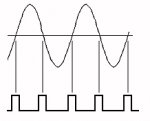I was contemplating adding an external Schmitt trigger to an input to possibly better detect (less jitter) the zero-cross point of an AC input. I am doing this for software triac triggering on a 28X2 and simply looping until the pin goes hi or lo. It works but the detection point timing seems to wander randomly which makes the triac harder to control, especially at the full off or full on points.
Looking up the Microchip data sheet for the PIC18F25K22, I have found one table that describes the I/O pins as TTL (Sec 1.0, Table 1-2 in the data sheet) and another that describes most of the inputs as ST (eg. Sec 10.0, Table 10-5, PortB).
Can anyone please clarify it for me? If the input(s) are already ST, it doesn't sound like an external ST would add anything(?).
Looking up the Microchip data sheet for the PIC18F25K22, I have found one table that describes the I/O pins as TTL (Sec 1.0, Table 1-2 in the data sheet) and another that describes most of the inputs as ST (eg. Sec 10.0, Table 10-5, PortB).
Can anyone please clarify it for me? If the input(s) are already ST, it doesn't sound like an external ST would add anything(?).



